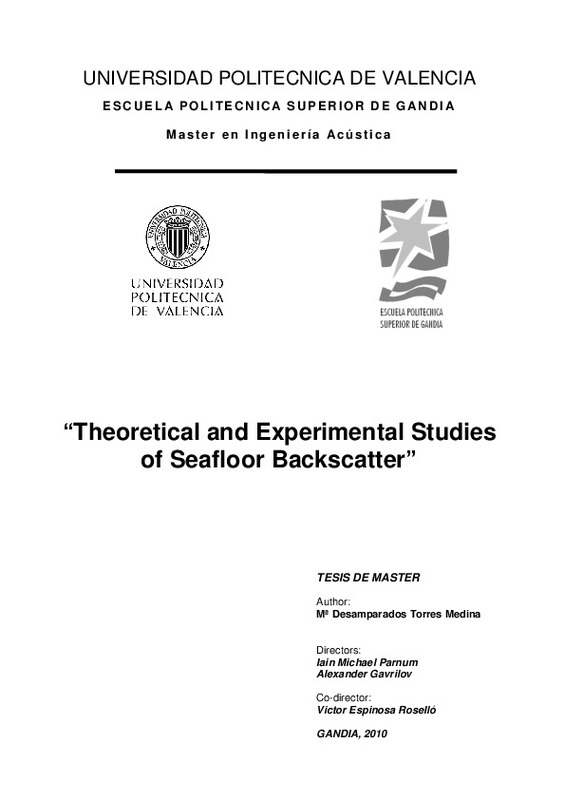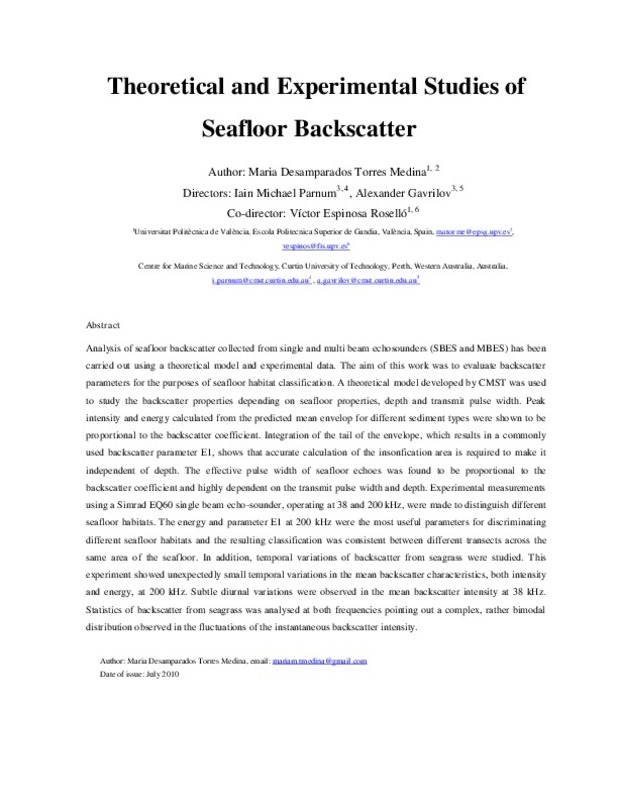JavaScript is disabled for your browser. Some features of this site may not work without it.
Buscar en RiuNet
Listar
Mi cuenta
Estadísticas
Ayuda RiuNet
Admin. UPV
Theoretical and experimental studies of seafloor backscatter
Mostrar el registro sencillo del ítem
Ficheros en el ítem
| dc.contributor.advisor | Parnum, Iain Michael
|
|
| dc.contributor.advisor | Gavrilov, Alexander
|
|
| dc.contributor.advisor | Espinosa Roselló, Víctor
|
|
| dc.contributor.author | Torres Medina, Mª Desamparados
|
es_ES |
| dc.date.accessioned | 2010-12-20T08:29:23Z | |
| dc.date.available | 2010-12-20T08:29:23Z | |
| dc.date.created | 2010-07-15 | |
| dc.date.issued | 2010-12-20 | |
| dc.identifier.uri | http://hdl.handle.net/10251/8989 | |
| dc.description.abstract | Analysis of seafloor backscatter collected from single and multi beam echosounders (SBES and MBES) has been carried out using a theoretical model and experimental data. The aim of this work was to evaluate backscatter parameters for the purposes of seafloor habitat classification. A theoretical model developed by CMST was used to study the backscatter properties depending on seafloor properties, depth and transmit pulse width. Peak intensity and energy calculated from the predicted mean envelop for different sediment types were shown to be proportional to the backscatter coefficient. Integration of the tail of the envelope, which results in a commonly used backscatter parameter E1, shows that accurate calculation of the insonfication area is required to make it independent of depth. The effective pulse width of seafloor echoes was found to be proportional to the backscatter coefficient and highly dependent on the transmit pulse width and depth. Experimental measurements using a Simrad EQ60 single beam echo-sounder, operating at 38 and 200 kHz, were made to distinguish different seafloor habitats. The energy and parameter E1 at 200 kHz were the most useful parameters for discriminating different seafloor habitats and the resulting classification was consistent between different transects across the same area of the seafloor. In addition, temporal variations of backscatter from seagrass were studied. This experiment showed unexpectedly small temporal variations in the mean backscatter characteristics, both intensity and energy, at 200 kHz. Subtle diurnal variations were observed in the mean backscatter intensity at 38 kHz. Statistics of backscatter from seagrass was analysed at both frequencies pointing out a complex, rather bimodal distribution observed in the fluctuations of the instantaneous backscatter intensity. | es_ES |
| dc.language | Inglés | es_ES |
| dc.publisher | Universitat Politècnica de València | es_ES |
| dc.rights | Reserva de todos los derechos | es_ES |
| dc.subject.other | Máster Universitario en Ingeniería Acústica-Màster Universitari en Enginyeria Acústica | es_ES |
| dc.title | Theoretical and experimental studies of seafloor backscatter | es_ES |
| dc.type | Tesis de máster | es_ES |
| dc.rights.accessRights | Abierto | es_ES |
| dc.contributor.affiliation | Universitat Politècnica de València. Departamento de Física Aplicada - Departament de Física Aplicada | es_ES |
| dc.contributor.affiliation | Universitat Politècnica de València. Instituto de Investigación para la Gestión Integrada de Zonas Costeras - Institut d'Investigació per a la Gestió Integrada de Zones Costaneres | es_ES |
| dc.contributor.affiliation | Universitat Politècnica de València. Escuela Politécnica Superior de Gandia - Escola Politècnica Superior de Gandia | es_ES |
| dc.contributor.affiliation | Universitat Politècnica de València. Instituto de Tecnología Eléctrica - Institut de Tecnologia Elèctrica | es_ES |
| dc.description.bibliographicCitation | Torres Medina, MD. (2010). Theoretical and experimental studies of seafloor backscatter. Universitat Politècnica de València. http://hdl.handle.net/10251/8989 | es_ES |
| dc.description.accrualMethod | Archivo delegado | es_ES |
Este ítem aparece en la(s) siguiente(s) colección(ones)
-
EPSG - Trabajos académicos [4726]
Escuela Politécnica Superior de Gandia







